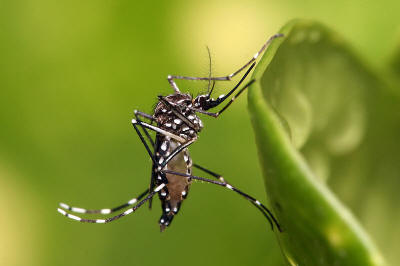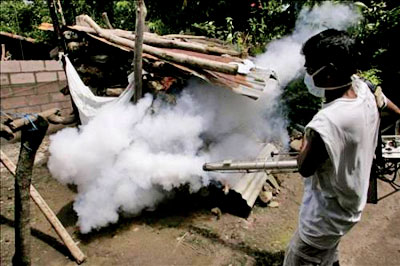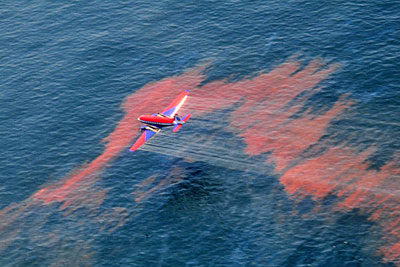|
|
|
17 July 2010 from VoltaireNet Website
Yet Hank Albarelli’s probe reveals that the US Army and CIA have been experimenting with dengue fever for years with the aim of weaponizing insects to be released against unwitting populations, as was previously done in Florida and elsewhere.
Moreover, Albarelli draws attention to the eerie similarity between dengue fever symptoms and those linked to the toxic emanations in the Gulf of Mexico and warns of the looming disaster that could unfold from the overlap.
Florida Keys Mosquito
Control aerial spraying
With little fanfare on July 13, Florida
officials released the findings of a Centers for Disease Control
(CDC) study conducted recently in the Key West area revealing that
about 10 percent, or 1,000 people, of the coastal town’s population
are infected with the dengue fever virus.
Following the spraying a small amount of other cases were reported, including that of a 41-year old Key West man who found blood in his urine and had severely aching joints.
Following these additional reports, the CDC launched its study of antibodies in Key West residents and found that 5 percent of the town’s residents have been exposed to the dengue virus.
Said CDC dengue expert, Dr. Christopher J. Gregory,
Gregory also stated,
Despite the low-key nature of the
Florida release, the Homeland Security Administration immediately
issued a “terror alert” concerning the findings, and Monroe County,
within which Key West is located, also issued its own Health
Advisory warning “effective immediately.”
Eadie added,
Dengue fever is a virus-based disease spread by the bites of mosquitoes. It can be caused by any one of four separate but related viruses carried by infected mosquitoes, most commonly the mosquito Aedes aegypti, found in tropic and subtropic areas.
It is commonly found in Southeast Asia, South and Central America, Indonesia, and Sub-Saharan Africa. Over the past several decades it has been consistently reported that dengue fever has been eradicated in North America.
Dengue hemorrhagic fever is a far more severe form of the dengue virus. If untreated it can be fatal. The chief symptoms of dengue fever are a high fever, severe headache, strong pain behind the eyes, joint, muscle and bone pain, easy bruising, rash, and mild bleeding from the nose and gums. There is no cure or vaccine for dengue fever.
One can only treat the symptoms in such
ways as getting plenty of rest, drink plenty of water, take pain
relievers with acetaminophen, and promptly consult a skilled
physician.
Prior to the recent Key West findings
and still today, the CDC has consistently reported that there have
been no outbreaks of dengue fever in Florida since 1934, and none in
the continental U.S. since 1946. Remarkably, this report is
incorrect.
As early as the 1950s, the army’s Fort Detrick in partnership with the CIA launched a multi-million dollar research program under which dengue fever and several addition exotic diseases were studied for use in offensive biological warfare attacks.
Indeed, as several CIA documents, as well as the findings of a 1975 Congressional committee reveal that 3 sites in Florida, Key West, Panama City, and Avon Park, as well as 2 other locations in central Florida, were used for experiments with mosquito borne dengue fever and other biological substances.
The experiments in Avon Park, about 170 miles from Miami, were covertly conducted in a low-income African American neighborhood that contained several newly constructed public housing projects.
CIA documents related to Project MK/NAOMI clearly indicate that the mosquitoes used in Avon Park were the Aedes aegypti type.
Interestingly, at the same time experiments were conducted in Florida there were at least two cases of dengue fever reported among civilian researchers at Fort Detrick in Maryland. Avon Park residents still living in the area say that the experiments resulted in “at least 6 or 7 deaths".
One elderly resident told this journalist,
A 1978 Pentagon publication, entitled Biological Warfare: Secret Testing & Volunteers, reveals that the Army’s Chemical Corps and Special Operations and Projects Divisions at Fort Detrick conducted “tests” similar to the Avon Park experiments in Key West, but the bulk of the documentation concerning this highly classified and covert work is still held by the Pentagon as “secret.”
One former Fort Detrick researcher says
that the army “performed a number of experiments in the area of the
Keys” but that “not all concerned dengue virus.”
Prior to this outbreak, Cuba had reported only a very small number of cases in 1944 and 1977. At the same time as the 1981 outbreak, covert biological warfare attacks on Cuba’s residents and crops were believed to have been conducted against the island by CIA contractors and military airplane flyovers.
Particularly harmful to the nation was a severe outbreak of swine flu that Fidel Castro attributed to the CIA.
In 1985 and 1986, authorities in Nicaragua accused the CIA of creating a massive outbreak of dengue fever that infected thousands in that country.
CIA officials denied any involvement, but army researchers admitted that intensive work with arthropod vectors for offensive biowarfare objectives had been conducted at Fort Detrick in the early 1980s, having first started in the early 1950s.
Fort Detrick researchers reported that
huge colonies of mosquitoes infected with not only dengue virus but
also yellow fever were maintained at the Frederick, Maryland
installation, as well as hordes of flies carrying cholera and
anthrax, and thousands of ticks filled with Colorado fever and
relapsing fever.
Freedom of Information requests filed
months ago for details on these early experiments remain unanswered.
Worse yet, there looms the possibility
that
Corexit and other toxins present in the Gulf area may weaken
the immune system, thus setting the stage for more severe forms of
the disease in people who are, or have previously been, exposed to
the virus.
If Dengue fever also spreads within the
Gulf community, affecting a significant number of people, it will be
increasingly difficult to differentiate the cause of symptoms in
those who develop them; even in persons who test positive for Dengue
exposure, the additional possibility remains that chemical toxicity
is present as well.
According to the CDC, milder cases of Dengue fever are identified by a high fever accompanied by at least two of the following symptoms:
In more severe cases, Dengue can cause:
The American Journal of Tropical
Medicine and Hygiene has reported cases of Dengue fever that
resulted in neurological manifestations, as well.
As if this were not troubling enough, let us compare the above symptom picture to the symptoms associated with exposure to the dispersants Corexit 9500 and Corexit 9527.
The exact risks of exposure to these chemicals have yet to be determined; in fact, the manufacturers’ material safety data sheet (MSDS) for Corexit 9500 states:
The MSDS further states that one should not come in contact with the product or breathe its vapors, and that adequate protective skin protection and breathing apparatuses should be worn when handling or working with the compound.
Any hints of safe usage within the MSDS
on these chemicals should be viewed from the following perspective:
the MSDS data assumes limited exposure (for example, while applying
the chemical) and the use of adequate protective gear. These
statistics do not apply, therefore, to unprotected people who may be
subject to long term, consistent exposure.
Dr. Susan Shaw, a marine toxicologist, talked about her recent experience with shrimpers who had been working in the Gulf waters. In an interview on CNN, she addressed the situation of a shrimper who had thrown his net into water, causing the water to splash onto his unprotected skin.
She reported that he developed a,
She asserts that the combination of oil from the well, combined with Corexit dispersant, increases the toxicity of both substances.
In combination, she believes that they
are skin permeable, and that they aerosolize to produce a breathing
hazard as well. The toxins can enter the body through the
respiratory tract, but are unlikely to remain localized in the
lungs, instead spreading throughout one’s entire body system.
More troubling reports, such as those of
the shrimpers mentioned above, have included bleeding from the nose
and from the rectum, as well as permanent numbness in extremities,
and complete loss of the sense of smell. It is generally accepted in
the medical literature that although the initial, acute presentation
of toxic exposure is generally the most severe, symptoms may linger
indefinitely or even result in permanent damage to the body.
In addition to the dispersants themselves, Gulf residents are potentially suffering from exposure to benzene, and other toxic chemicals that are naturally present in crude oil, as well as several potentially toxic gases being released from the well.
In combination with the dispersant, the exact toxicity risk of these chemicals remains unknown. Add now, to the picture, the risk of having contracted Dengue fever, and the puzzle becomes more difficult to piece together.
The CDC’s 2009 survey contained samples
from only 240 households, and determined that about 5% of the
residents had antibodies to the Dengue virus, indicating either
current infection or a prior exposure. This relatively small sample
may not be indicative of the Florida population as a whole, and may
not be a valid indicator of the overall number of exposed people in
the surrounding areas.
A second infection with
Dengue, however, can lead to a much more severe presentation of the
disease, and a greater likelihood of it progressing to its
hemorrhagic (and potentially fatal) form. Likewise, the literature
indicates that a severe assault to the immune system presents a risk
of virus reactivation and resultant disease.
Such immune system suppression or
damage, it seems, could then reactivate Dengue fever in residents
who carry the latent virus, perhaps even resulting in a more severe
form of the disease’s presentation.
Not only is there a tremendous symptom overlap between Dengue virus and toxin exposure, up to and including the potential for a hemorrhagic presentation of both, but there looms on the horizon a new and frightening possibility:
|





